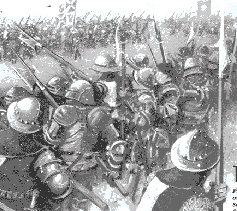| | STRUGGLE FOR THE THRONE: Crimson Snow | |  BATTLE OF TOWTON |
Second St Albans had lost the Yorkists the custody of the king. They could no longer command the obedience of his subjects. When Edward, now calling himself Duke of York, entered London, he was cheered and welcomed by the Londoners as a hero. It became clear to the Yorkists that they no longer needed Henry under their control. On March 4, 1461, in the Great Hall of the Palace of Westminster, Edward was formally proclaimed King of England. Though he was king, Edward was by no means in control. The pro Lancastrian north posed an enormous threat to his infant kingship. Edward also lacked support from a large section of the nobility. The earls of Northumberland, Wiltshire, Devon and Shrewsbury, the dukes of Exeter and Somerset, and Lords Clifford, Roos, Dacre and Scales all sided with Lancaster. Edward needed a significant victory to secure his throne. The battle of Towton would be this victory, but it was won at a very high price. It was the longest and largest of any battle of the Wars, and carries the grim epithet of being the bloodiest battle ever fought on English soil. The field in which the battle was fought would later be known as "Bloody Meadow". Edward left London on March 13. The retreating Lancastrian army had wreaked havoc, pillaging in the countryside heading north, and this certainly helped Edward's cause. By the time he caught up to the Lancastrians outside York, he had been joined by thousands more men. To these troops would be added the men recuited by Warwick and the Duke of Norfolk. Edward sent a detachment under Lord Fitzwalter to seize the bridge at Ferrybridge on March 18. They found the bridge broken down, but unguarded, and spent the day repairing it. Fitzwalter's men were caught completely unaware by a dawn attack led by Lord Clifford and the Yorkists were forced back across the river. Edward immediately sent another force upstream to cross the river at Castleford and cut off Clifford's retreat. This fresh force caught Clifford's men and killed most of them within sight of their lines. Somerset, for reasons known only to himself, sent no troops to help the unfortunate Clifford, but instead waited for the advance of the main Yorkist army. On March 29, Palm Sunday, Edward marched his forces north to meet the Lancastrians, and his army encamped on the hill south of the village of Saxton, about ten miles south of York. The Lancastrians took up their position half a mile to the north of the Yorkists on higher ground. A fierce snow storm was raging around both armies. Behind the Yorkist army was the road to London and the River Aire. The Yorkists could be defeated by being pushed backed and trapped by the river. The Lancastrian position appeared superior, but if defeated, their escape routes were limited. On their right was the Cock Beck River, which was flooding due to the snow, on their left was the road to Tadcaster, which was also flooding. Both armies were in precarious positions; it was do or die now. From the first the Lancastrians were at a disadvantage as the wind was blowing the snow in their direction and they were unable to see the enemy or to judge distances. Their arrows continually missed their targets, and were being picked up by the Yorkists and fired back at them. The Lancastrians soon realized what was happening and the order was given to charge into battle across the meadow. For two hours they engaged in a savage confrontation. There were so many bodies on the snow that it became colored crimson. The battle continued fiercely throughout the day. Late in the afternoon, the troops sent by Norfolk arrived, and the Lancastrians, having been pushed back, turned and fled. So many men tried to escape across the Cock Beck that the bridge collapsed. With the Yorkists in hot pursuit, the Lancastrians had no choice but to plunge into the icy waters in an attempt to escape. So many men drowned in the water it was said to run red many miles from the battlefield. The battle had lasted about ten hours, from approximately eleven in the morning until nine at night, but the rout lasted for much longer, many Lancastrians being chased for miles. Edward estimated that about 20,000 men had died in the battle; contemporary chroniclers put it as high as 28,000. However, this number includes only the dead on the battlefield. Many more were killed during the rout. The Lancastrians lost some of their best battle captains: the earls of Northumberland, Devon and Wiltshire, Sir Richard Percy and Sir Andrew Trollope, Lords Dacre and Welles were among the dead. With their armies all but annihilated, the Lancastrians would be unable to put an effective force in the field for several years. Two huge pits were dug, one at Saxton and another near the Cock Beck, and hundreds of bodies were buried in together. Despite Towton’s bloody ferocity, Henry and Margaret were able to escape to Scotland, there to plot and scheme away to bring the Lancastrians back to power. 

|
 Free Forum Hosting
Free Forum Hosting